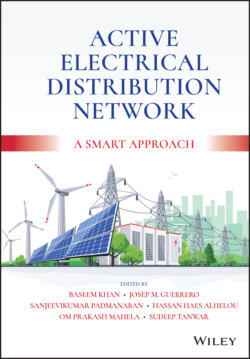Читать книгу Active Electrical Distribution Network - Группа авторов - Страница 64
3.3.1.7 Network Restructuring
ОглавлениеDue to the low-voltage–high-current operating scenarios of the distribution system, I2R losses are the major concern of DNOs and need to be taken care off to improve the performance of the system. Network restructuring is one of the methods to deal with this problem, which is generally used in low-voltage distribution systems. It is a very effective and conclusive method to save the electrical energy. Distribution systems consist of a large number of interconnected radial and mesh networks. The network configuration and structures of distribution systems may be varied through switching operations to reallocate loads in the feeders with exhaustive planning. This can be executed through two types of switches, which are often used in primary as well as secondary distribution systems:
Sectionalizing switches (normally closed switches) or
Tie switches (normally open switches)
These types of switches are particularly structured for protection and configuration supervision of complicated distribution systems. Network reconfiguration is the commonly used process of altering the distribution systems topology by changing the open/closed position of the switches. Reconfiguration is primarily applied for:
1 Service restoration during faulty conditions
2 Load balancing forrelease of overburdened power lines andto improve the overall voltage profile
3 Planning the line outages for maintenance conditions and
4 Loss reduction
Loss minimization executed by the switching operation is found to be the elementary control action in network restructuring. The prime activity is the closing of the switches in an opened branch and opening the switch in a closed one by maintaining the network state radial. However, due to the possibility of several candidates switching combinations in the system at the same time, it is a complex combinatorial problem. This distinct feature of the availability of numerous switch combinations makes it a discrete optimization.
Recurring changes in formation can cause outages or transient problems. However, network restructuring has proved to be a complex combinatorial decision-making execution for contributors to trace, which generally requires extensive numerical designs and scheming, and affects the management of the control strategies of protective devices. In feeder reconfiguration, it is usually assumed that the protecting elements are precisely harmonized and correlate when the feeder configurations are altered by acute switch operations, which are achieved through essential protective device planning and coordination, usually carried out for secure configuration [22].
